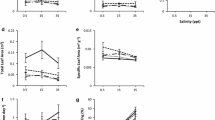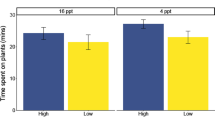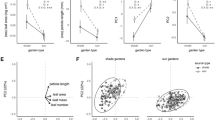Abstract
Differences among individuals within species affect community and ecosystem processes in many systems, and may rival the importance of differences between species. Intraspecific variation consists of both plastic and genetic components that are regulated by different processes and operate on different time scales. Therefore, probing which mechanisms can affect traits sufficiently strongly to affect ecosystem processes is fundamental to understanding the consequences of individual variation. We find that a dominant deciduous tree of Pacific Northwest riparian ecosystems, red alder, exhibits strong and synergistic responses to nutrient resources and herbivory stress. These induced responses, which include shifting nutrient and plant secondary metabolite composition, have cascading effects on aquatic ecosystem function. Defense responses suppress leaf litter decomposition in small streams, thus altering the rate of energy capture for one of the most abundant terrestrial carbon sources entering aquatic systems. We find that alder responses to herbivory stress largely depend on availability of soil nutrients, with modification of the highly cytotoxic diarylheptanoid group of secondary metabolites being favored in nutrient-poor environments and modification of the typically dose-dependent ellagitannins being favored in nutrient-rich environments. Importantly, these findings identify traits for herbivore resistance in alder trees and demonstrate that plastic responses occurring within a species and over short time scales substantially alter a key function of an adjacent ecosystem. Furthermore, demonstrating plasticity among alder secondary metabolites lends insight into this system, in which decomposer communities are known to adjust to the secondary chemistry of local alder trees to facilitate rapid decomposition of locally derived leaf litter.






Similar content being viewed by others
References
Agrawal AA (1998) Induced responses to herbivory and increased plant performance. Science 279:1201–1202
Agrawal AA (1999) Induced responses to herbivory in wild radish: effects of several herbivores and plant fitness. Ecology 80:1713–1723
Agrawal AA (2007) Macroevolution of plant defense strategies. Trends Ecol Evol 22:103–109
Anderson NH, Sedell JR (1979) Detritus processing by macroinvertebrates in stream ecosystems. Annu Rev Entomol 24:351–377
Ballaré CL (2014) Light regulation of plant defense. Annu Rev Plant Biol 65:335–363
Barbour RC, O’Reilly-Wapstra JM, DeLittle DW, Jordan GJ, Steane DA, Humphreys JR, Bailey JK, Whitham TG, Potts BM (2009) A geographic mosaic of genetic variation within a foundation tree species and its community-level consequences. Ecology 90:1762–1772
Brown KR, Courtin PJ, Negrave RW (2011) Growth, foliar nutrition and δ13C responses of red alder (Alnus rubra) to phosphorus additions soon after planting on moist sites. For Ecol Manag 262:791–802
Bruin J, Sabelis MW, Dicke M (1995) Do plants tap SOS signals from their infested neighbours? Trends Ecol Evol 10:167–170
Crutsinger GM, Collins MD, Fordyce JA, Gompert Z, Nice CC, Sanders NJ (2006) Plant genotypic diversity predicts community structure and governs an ecosystem process. Science 313:966–968
Crutsinger GM, Souza L, Sanders NJ (2008) Intraspecific diversity and dominant genotypes resist plant invasions. Ecol Lett 11:16–23
Farrand L, Kim JY, Byun S, Im-aram A, Lee J, Suh JY, Lee KW, Lee HJ, Tsang BK (2014) The diarylheptanoid hirsutenone sensitizes chemoresistant ovarian cancer cells to cisplatin via modulation of apoptosis-inducing factor and X-linked inhibitor of apoptosis. J Biol Chem 289:1723–1731
Feeny P (1976) Plant apparency and chemical defense. In: Wallace JW, Mansell RL (eds) Biochemical interaction between plants and insects. Springer, Boston, pp 1–40
Gökkaya K, Hurd TM, Raynal DJ (2006) Symbiont nitrogenase, alder growth, and soil nitrate response to phosphorus addition in alder (Alnus incana ssp. rugosa) wetlands of the Adirondack Mountains, New York State, USA. Environ Exp Bot 55:97–109
Gómez S, Ferrieri RA, Schueller M, Orians CM (2010) Methyl jasmonate elicits rapid changes in carbon and nitrogen dynamics in tomato. New Phytol 188:835–844
Hendry AP (2015) Key questions on the role of phenotypic plasticity in eco-evolutionary dynamics. J Hered 107:25–41
Hersch-Green EI, Turley NE, Johnson MTJ (2011) Community genetics: what have we accomplished and where should we be going? Philos Trans R Soc B Biol Sci 366:1453–1460
Jackrel SL, Wootton JT (2014) Local adaptation of stream communities to intraspecific variation in a terrestrial ecosystem subsidy. Ecology 95:37–43
Jackrel SL, Wootton JT (2015a) Cascading effects of induced terrestrial plant defences on aquatic and terrestrial ecosystem function. Proc R Soc Lond B Biol Sci 282:1805
Jackrel SL, Wootton JT (2015b) Diversity of riparian plants among and within species shapes river communities. PLoS One 10:e0142362
Jackrel SL, Morton TC, Wootton JT (2016) Intraspecific leaf chemistry drives locally accelerated ecosystem function in aquatic and terrestrial communities. Ecology 97:2125–2135
Johnson R, Wichern D (1992) Applied multivariate statistical methods. Prentice Hall, Englewood Cliffs
Kind T, Fiehn O (2007) Seven golden rules for heuristic filtering of molecular formulas obtained by accurate mass spectrometry. BMC Bioinform 8:105
Kovach-Orr C, Fussmann GF (2012) Evolutionary and plastic rescue in multitrophic model communities. Philos Trans R Soc Lond B Biol Sci 368:1610
LeRoy CJ, Whitham TG, Keim P, Marks JC (2006) Plant genes link forests and streams. Ecology 87:255–261
LeRoy CJ, Whitham TG, Wooley SC, Marks JC (2007) Within-species variation in foliar chemistry influences leaf-litter decomposition in a Utah river. J N Am Benthol Soc 26:426–438
Luken JO, Fonda RW (1983) Nitrogen accumulation in a chronosequence of red alder communities along the Hoh river, Olympic National Park, Washington. Can J For Res 13:1228–1237
Madritch MD, Hunter MD (2002) Phenotypic diversity influences ecosystem functioning in an oak sandhills community. Ecology 83:2084–2090
Martin LJ, Blossey B (2013) Intraspecific variation overrides origin effects in impacts of litter-derived secondary compounds on larval amphibians. Oecologia 173:449–459
Miner BG, Sultan SE, Morgan SG, Padilla DK, Relyea RA (2005) Ecological consequences of phenotypic plasticity. Trends Ecol Evol 20:685–692
Mithöfer A, Boland W (2012) Plant defense against herbivores: chemical aspects. Annu Rev Plant Biol 63:431–450
Mithöfer A, Wanner G, Boland W (2005) Effects of feeding Spodoptera littoralis on lima bean leaves. II. Continuous mechanical wounding resembling insect feeding is sufficient to elicit herbivory-related volatile emission. Plant Physiol 137:1160–1168
Monaghan EJ, Ruttenberg KC (1999) Dissolved organic phosphorus in the coastal ocean: reassessment of available methods and seasonal phosphorus profiles from the Eel River Shelf. Limnol Oceanogr 44:1702–1714
Nakagawa S, Schielzeth H (2013) A general and simple method for obtaining R2 from generalized linear mixed-effects models. Methods Ecol Evol 4:133–142
Niemetz R, Gross GG (2005) Enzymology of gallotannin and ellagitannin biosynthesis. Phytochemistry 66:2001–2011
Rahman A (2012) Studies in natural products chemistry, vol 37. Elsevier, Amsterdam
Rudolf VHW, Rasmussen NL (2013a) Ontogenetic functional diversity: size structure of a keystone predator drives functioning of a complex ecosystem. Ecology 94:1046–1056
Rudolf VHW, Rasmussen NL (2013b) Population structure determines functional differences among species and ecosystem processes. Nat Commun 4:2318
Salminen JP, Karonen M (2011) Chemical ecology of tannins and other phenolics: we need a change in approach. Funct Ecol 4:325–338
Schweitzer JA, Bailey JK, Rehill BJ, Martinsen GD, Hart SC, Lindroth RL, Keim P, Whitham TG (2004) Genetically based trait in a dominant tree affects ecosystem processes. Ecol Lett 7:127–134
Schweitzer JA, Bailey JK, Hart SC, Whitham TG (2005) Nonadditive effects of mixing cottonwood genotypes on litter decomposition and nutrient dynamics. Ecology 86:2834–2840
Schweitzer JA, Madritch MD, Bailey JK, LeRoy CJ, Fischer DG, Rehill BJ, Lindroth RL, Hagerman AE, Wooley SC, Hart SC, Whitham TG (2008) From genes to ecosystems: the genetic basis of condensed tannins and their role in nutrient regulation in a Populus model system. Ecosystems 11:1005–1020
Stamp N (2003) Out of the quagmire of plant defense hypotheses. Q Rev Biol 78:23–55
Stout R, Taft W, Merrit R (1985) Patterns of macroinvertebrate colonization on fresh and senescent alder leaves in two Michigan streams. Freshwater Biol 15:573-580
Strauss SY, Agrawal AA (1999) The ecology and evolution of plant tolerance to herbivory. Trends Ecol Evol 14:179–185
Tank JL, Rosi-Marshall EJ, Griffiths NA, Entrekin SA, Stephen ML (2010) A review of allochthonous organic matter dynamics and metabolism in streams. J N Am Benthol Soc 29:118–146
Worthington NP, Johnson FA, Staebler GR, Lloyd WJ (1960) Normal yield tables for red alder. Pacific northwest forest and range experimental station. U.S. Department of Agriculture Forest Service
Acknowledgements
We thank J.T. Wootton, C. Pfister, T. Price, J. Bergelson and G. Dwyer for constructive comments and discussion on this work and L. Harris for assistance in the field. We thank Merrill & Ring Inc. and J. Murray for facilitating research on their lands, A. Colman, A. Mine, G. Olack, and the Colman Isotope Lab at University of Chicago for assistance with nitrogen, carbon and phosphorus analyses, and D. Hurd and M. Hurd for providing work facilities.
Funding
This work was supported by the NSF GRFP, the DOE GAANN, NSF DDIG DEB-1311293, ARCS® (Achievement Rewards for College Scientists) Foundation, Inc.’s Scholar Illinois Chapter (2014 and 2015), National Geographic Young Explorer’s Grant, and University of Chicago Hinds Fund grants to SLJ; an Olympic Natural Resources Grant and NSF grant DEB 09-19420 to J.T. Wootton; and an NSF grant OCE-0928232 to C.A. Pfister.
Author information
Authors and Affiliations
Contributions
SLJ conceived and designed the study, conducted field experiments, generated the nutrient and mass spectra data, performed statistical analyses and wrote the manuscript. TCM design secondary metabolite analyses, generated the mass spectra data, characterized secondary metabolites and assisted with writing the manuscript.
Corresponding author
Ethics declarations
Conflict of interest
We have no competing interests.
Data availability
All leaf decomposition and nutrient data can be found here: http://dx.doi.org/10.5061/dryad.ph812. A subset of mass spectra chromatograms and details about identifying secondary metabolites are available in our supplementary materials. Contact authors for remaining mass spectra.
Ethical approval
This article does not contain any studies with human participants or animals performed by any of the authors.
Additional information
Communicated by Amy Austin.
We document that plasticity in secondary metabolites occurring within plants over short times scales affects the rate of leaf decomposition in adjacent river ecosystems. This work changes our understanding of the temporal stability and regulation of this ecosystem function.
Electronic supplementary material
Below is the link to the electronic supplementary material.
Rights and permissions
About this article
Cite this article
Jackrel, S.L., Morton, T.C. Inducible phenotypic plasticity in plants regulates aquatic ecosystem functioning. Oecologia 186, 895–906 (2018). https://doi.org/10.1007/s00442-018-4094-6
Received:
Accepted:
Published:
Issue Date:
DOI: https://doi.org/10.1007/s00442-018-4094-6




